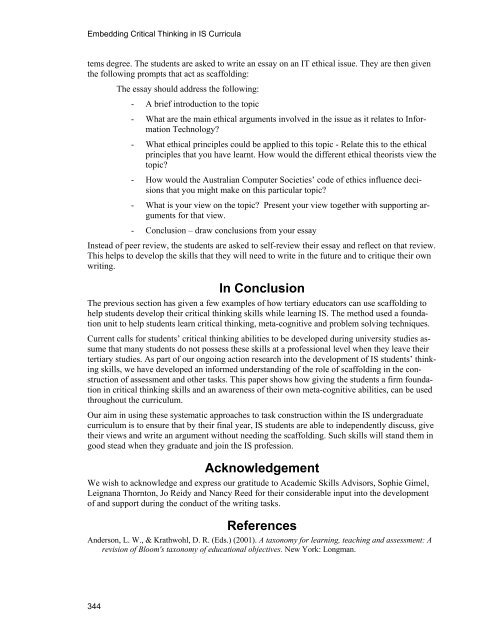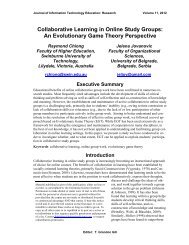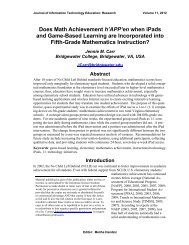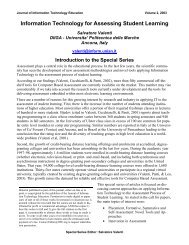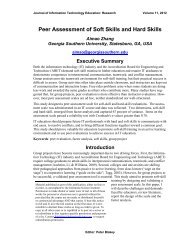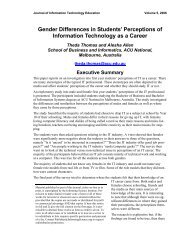Embedding Critical Thinking in IS Curricula tems degree. The students are asked to write an essay on an IT ethical issue. They are then given the following prompts that act as scaffolding: 344 The essay should address the following: - A brief introduction to the topic - What are the main ethical arguments involved in the issue as it relates to <strong>Information</strong> Technology? - What ethical principles could be applied to this topic - Relate this to the ethical principles that you have learnt. How would the different ethical theorists view the topic? - How would the Australian Computer Societies’ code <strong>of</strong> ethics influence decisions that you might make on this particular topic? - What is your view on the topic? Present your view together with supporting arguments for that view. - Conclusion – draw conclusions from your essay Instead <strong>of</strong> peer review, the students are asked to self-review their essay and reflect on that review. This helps to develop the skills that they will need to write in the future and to critique their own writing. In Conclusion The previous section has given a few examples <strong>of</strong> how tertiary educators can use scaffolding to help students develop their critical thinking skills while learning IS. The method used a foundation unit to help students learn critical thinking, meta-cognitive and problem solving techniques. Current calls for students’ critical thinking abilities to be developed during university studies assume that many students do not possess these skills at a pr<strong>of</strong>essional level when they leave their tertiary studies. As part <strong>of</strong> our ongoing action research into the development <strong>of</strong> IS students’ thinking skills, we have developed an informed understanding <strong>of</strong> the role <strong>of</strong> scaffolding in the construction <strong>of</strong> assessment and other tasks. This paper shows how giving the students a firm foundation in critical thinking skills and an awareness <strong>of</strong> their own meta-cognitive abilities, can be used throughout the curriculum. Our aim in using these systematic approaches to task construction within the IS undergraduate curriculum is to ensure that by their final year, IS students are able to independently discuss, give their views and write an argument without needing the scaffolding. Such skills will stand them in good stead when they graduate and join the IS pr<strong>of</strong>ession. Acknowledgement We wish to acknowledge and express our gratitude to Academic Skills Advisors, Sophie Gimel, Leignana Thornton, Jo Reidy and Nancy Reed for their considerable input into the development <strong>of</strong> and support during the conduct <strong>of</strong> the writing tasks. References Anderson, L. W., & Krathwohl, D. R. (Eds.) (2001). A taxonomy for learning, teaching and assessment: A revision <strong>of</strong> Bloom's taxonomy <strong>of</strong> educational objectives. New York: Longman.
Thomas, Davis, & Kazlauskas Anewalt, K. (2003). A pr<strong>of</strong>essional practice component in writing: A simple way to enhance an existing course. <strong>Journal</strong> <strong>of</strong> Computer Sciences in College, 18(3), 155-165. Consortium for Computer Sciences in Colleges. Ayersman, D. J., & Reed, W. M. (1995-1996). Effects <strong>of</strong> learning styles, programming, and gender on computer anxiety. <strong>Journal</strong> <strong>of</strong> Research on Technology in Education, 28(2), 148-161. Bloom, B. Englehart, M. Furst, E., Hill, W., & Krathwohl, D. (1956). Taxonomy <strong>of</strong> educational objectives: The classification <strong>of</strong> educational goals. Handbook 1: Cognitive Domain. New York, Toronto: Longmans, Green. Davis, T., Thomas, T., & Kazlauskas, A. (2006). What were you thinking? Empowering tomorrow’s pr<strong>of</strong>essionals today. International <strong>Journal</strong> <strong>of</strong> Pedagogies and Learning, 2(1), 34-46. de Bono, E. (1976). Teaching Thinking. London: Maurice Temple Smith Ltd. Driskill, L., Lewis, K., Stearns, J., & Volz, T. (1998, April). Students’ reasoning and rhetorical knowledge in first-year chemistry. Language and Learning across the Disciplines, 2(3), 3-24. Fagin, B., Harper, J. Baird, L., Hadfield, S., & Sward, R., (2006). Critical thinking and computer science: Implicit and explicit connections. <strong>Journal</strong> <strong>of</strong> Computing Sciences in Colleges, 21(4), 171-177. Gorgone, J. T., Davis G. B., Valcich, J. S., Topic, H., Feinstein, D. L. & Longenecker, H. E., Jr. (2002). Model curriculum and guidelines for undergraduate degree programs in information systems. Association <strong>of</strong> <strong>Information</strong> Systems, Available from URL: http://www.aisnet.org/Curriculum/ Grant, N. S. (2003). A study on critical thinking, cognitive learning style and gender in various information science programming classes, Proceedings <strong>of</strong> CITC4’03, October 16-18, Lafayette, Indiana, USA, pp 96-99. Holton, D., & Clarke, D. (2006). Scaffolding and metacognition. International <strong>Journal</strong> <strong>of</strong> Mathematical Education in Science and Technology, 17(2), 127-143. Hung, W., & Lockard, J. (2006). Students’ perception <strong>of</strong> knowledge activation on a guided collaborative problem solving organizer. Proceedings <strong>of</strong> the 7 th Annual Conference on Learning Sciences, p.270- 276. Jelfs, A., Nathan, R., & Barrett, C. (2004). Scaffolding students: Suggestions on how to equip students with the necessary skills for studying in a blended learning environment. <strong>Journal</strong> <strong>of</strong> Educational Media, 29(2), 85-96. Jones, H. M. (1997). An introduction to critical thinking. Riverwood, NSW, Australia: Social Science Press. Kaste, J. (2004). Scaffolding through cases: Diverse constructivist teaching in the literacy methods course. Teaching and Teacher Education, 20, 31-45. Krishna Rao, M. R. K. (2005). Infusing critical thinking skills into content <strong>of</strong> AI course. Proceedings <strong>of</strong> ITiCSE’05, June 27-29, Mone de Caparica, Portugal, pp173-177. Mayer, R. E., Dyck, W., & Vilberg, W. (1986). Learning to program and learning to think: What's the connection? Communications <strong>of</strong> the ACM, 29(7), 605-610. McDowell, C., Werner, L., Bullock, H. E., & Fernald, J. (2006). Pair programming improves student retention, confidence, and program quality. Communications <strong>of</strong> the ACM, 49(8), 90-95. Monk, A., & Howard, S. (1998). The Rich Picture: A tool for reasoning about work context. Interactions, March + April, 21-30. Norris, C., & Jackson, L. (1992). The effect <strong>of</strong> computer science instruction on critical thinking skills and mental alertness. <strong>Journal</strong> <strong>of</strong> Research on Computing in Education, 24(3), 329-337. Pascarella, E. T., & Terenzini, P. T. (1991). How college affects students: Findings and insights from twenty years <strong>of</strong> research. San Francisco: Jossey-Bass. Ramsden, P. (2003). Learning to teach in higher education (2nd ed.). London: Routledge Falmer. 345
- Page 1 and 2: Journal of Information Technology E
- Page 3 and 4: Thomas, Davis, & Kazlauskas Bloom
- Page 5 and 6: Thomas, Davis, & Kazlauskas thinkin
- Page 7 and 8: Thomas, Davis, & Kazlauskas ing ski
- Page 9 and 10: Thomas, Davis, & Kazlauskas try, ab
- Page 11 and 12: Thomas, Davis, & Kazlauskas The exa
- Page 13 and 14: Thomas, Davis, & Kazlauskas There i
- Page 15 and 16: Thomas, Davis, & Kazlauskas As part
- Page 17: Thomas, Davis, & Kazlauskas resourc


